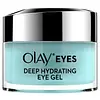What's inside
What's inside
 Key Ingredients
Key Ingredients

 Benefits
Benefits

 Concerns
Concerns

 Ingredients Side-by-side
Ingredients Side-by-side

Water
Skin ConditioningGlycerin
HumectantCaprylic/Capric Triglyceride
MaskingGlyceryl Stearate Citrate
EmollientJojoba Esters
EmollientDiisostearyl Malate
EmollientC10-18 Triglycerides
EmollientCetearyl Alcohol
EmollientSilica
AbrasivePalmitoyl Tripeptide-1
Skin ConditioningPalmitoyl Tetrapeptide-7
Skin ConditioningSoluble Collagen
HumectantSodium Hyaluronate
HumectantTocopherol
AntioxidantHelianthus Annuus Seed Oil
EmollientButylene Glycol
Humectant1,2-Hexanediol
Skin ConditioningPotassium Cetyl Phosphate
EmulsifyingPolysorbate 20
EmulsifyingPolysorbate 80
EmulsifyingIsohexadecane
EmollientSodium Acrylate/Sodium Acryloyldimethyl Taurate Copolymer
Emulsion StabilisingCarbomer
Emulsion StabilisingHydroxyacetophenone
AntioxidantDisodium EDTA
Water, Glycerin, Caprylic/Capric Triglyceride, Glyceryl Stearate Citrate, Jojoba Esters, Diisostearyl Malate, C10-18 Triglycerides, Cetearyl Alcohol, Silica, Palmitoyl Tripeptide-1, Palmitoyl Tetrapeptide-7, Soluble Collagen, Sodium Hyaluronate, Tocopherol, Helianthus Annuus Seed Oil, Butylene Glycol, 1,2-Hexanediol, Potassium Cetyl Phosphate, Polysorbate 20, Polysorbate 80, Isohexadecane, Sodium Acrylate/Sodium Acryloyldimethyl Taurate Copolymer, Carbomer, Hydroxyacetophenone, Disodium EDTA
Water
Skin ConditioningPropylene Glycol
HumectantGlycerin
HumectantNiacinamide
SmoothingDimethicone
EmollientPanthenol
Skin ConditioningSodium Hyaluronate
HumectantPalmitoyl Pentapeptide-4
Skin ConditioningCucumis Sativus Fruit Extract
EmollientCaprylyl Glycol
EmollientDimethiconol
EmollientHamamelis Virginiana Water
AstringentDisodium EDTA
Carbomer
Emulsion StabilisingAcrylates/C10-30 Alkyl Acrylate Crosspolymer
Emulsion StabilisingGlyceryl Acrylate/Acrylic Acid Copolymer
HumectantPvm/Ma Copolymer
Emulsion StabilisingAminomethyl Propanol
Buffering1,2-Hexanediol
Skin ConditioningPhenoxyethanol
PreservativeCamellia Sinensis Leaf Extract
AntimicrobialWater, Propylene Glycol, Glycerin, Niacinamide, Dimethicone, Panthenol, Sodium Hyaluronate, Palmitoyl Pentapeptide-4, Cucumis Sativus Fruit Extract, Caprylyl Glycol, Dimethiconol, Hamamelis Virginiana Water, Disodium EDTA, Carbomer, Acrylates/C10-30 Alkyl Acrylate Crosspolymer, Glyceryl Acrylate/Acrylic Acid Copolymer, Pvm/Ma Copolymer, Aminomethyl Propanol, 1,2-Hexanediol, Phenoxyethanol, Camellia Sinensis Leaf Extract
Ingredients Explained
These ingredients are found in both products.
Ingredients higher up in an ingredient list are typically present in a larger amount.
1,2-Hexanediol is a synthetic liquid and another multi-functional powerhouse.
It is a:
- Humectant, drawing moisture into the skin
- Emollient, helping to soften skin
- Solvent, dispersing and stabilizing formulas
- Preservative booster, enhancing the antimicrobial activity of other preservatives
Carbomer is a polymer of acrylic acid. Its main role is to create a gel consistency.
A high amount of carbomer can cause pilling or balling up of products. Don't worry, most products contain 1% or less of carbomer.
Disodium EDTA plays a role in making products more stable by aiding other preservatives.
It is a chelating agent, meaning it neutralizes metal ions that may be found in a product.
Disodium EDTA is a salt of edetic acid and is found to be safe in cosmetic ingredients.
Learn more about Disodium EDTAGlycerin is already naturally found in your skin. It helps moisturize and protect your skin.
A study from 2016 found glycerin to be more effective as a humectant than AHAs and hyaluronic acid.
As a humectant, it helps the skin stay hydrated by pulling moisture to your skin. The low molecular weight of glycerin allows it to pull moisture into the deeper layers of your skin.
Hydrated skin improves your skin barrier; Your skin barrier helps protect against irritants and bacteria.
Glycerin has also been found to have antimicrobial and antiviral properties. Due to these properties, glycerin is often used in wound and burn treatments.
In cosmetics, glycerin is usually derived from plants such as soybean or palm. However, it can also be sourced from animals, such as tallow or animal fat.
This ingredient is organic, colorless, odorless, and non-toxic.
Glycerin is the name for this ingredient in American English. British English uses Glycerol/Glycerine.
Learn more about GlycerinSodium Hyaluronate is hyaluronic acid's salt form. It is commonly derived from the sodium salt of hyaluronic acid.
Like hyaluronic acid, it is great at holding water and acts as a humectant. This makes it a great skin hydrating ingredient.
Sodium Hyaluronate is naturally occurring in our bodies and is mostly found in eye fluid and joints.
These are some other common types of Hyaluronic Acid:
Learn more about Sodium HyaluronateWater. It's the most common cosmetic ingredient of all. You'll usually see it at the top of ingredient lists, meaning that it makes up the largest part of the product.
So why is it so popular? Water most often acts as a solvent - this means that it helps dissolve other ingredients into the formulation.
You'll also recognize water as that liquid we all need to stay alive. If you see this, drink a glass of water. Stay hydrated!
Learn more about Water